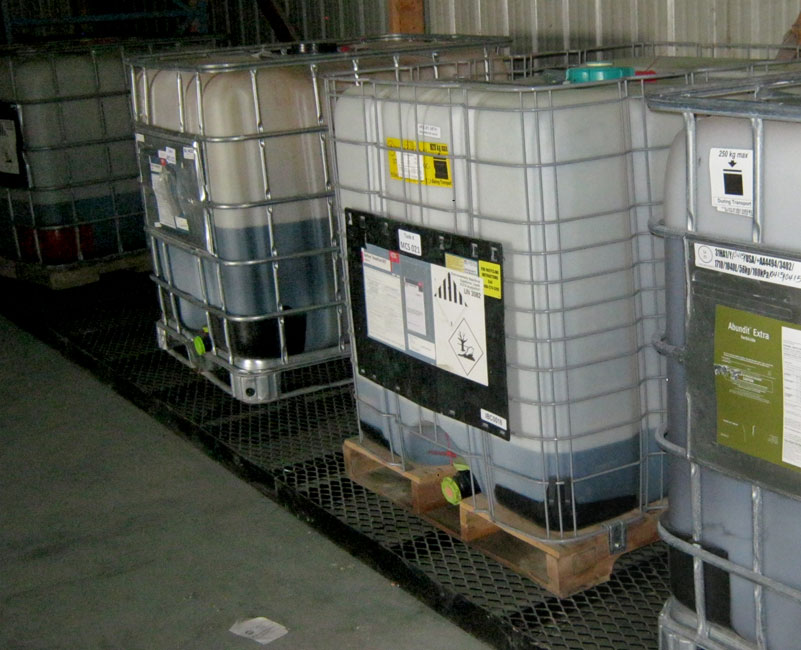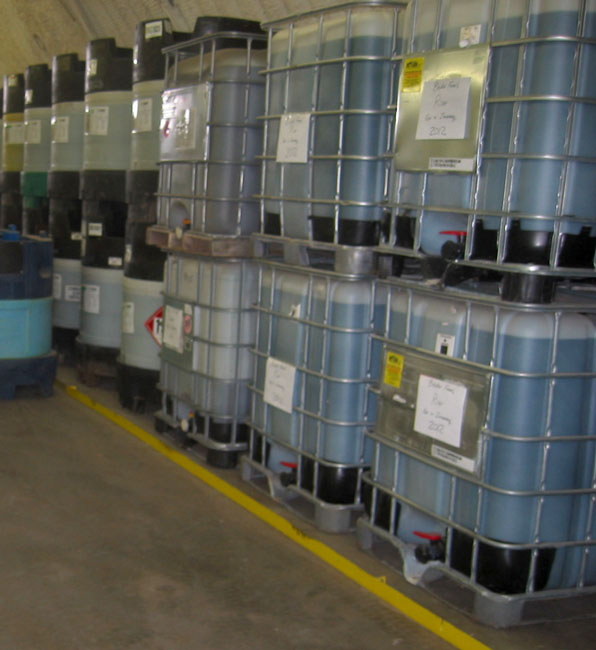If mini-bulk pesticides are used to impregnate dry fertilizer, an elevated flat load pad is required. The pad must be constructed of reinforced concrete or other Commissioner-approved materials. The load pad must be adequate size to fully hold a release from the application equipment being loaded. Load pads must be managed in a manner that will prevent pesticide contaminated runoff from leaving the area.
When using mini-bulk pesticides to impregnate dry fertilizer, the mini-bulk tank and the inductor must be inside a secondary containment area. If you are using small packaged pesticides to impregnate, a load pad is not required, although it is recommended.
1. Mini-bulk tanks must be secured against access by unauthorized persons and provide protection against access by wildlife.
2. Mini-bulk tanks must be protected against damage caused by moving vehicles.
3. Mini-bulk tanks must bear a current and complete label including the EPA Establishment number and the net gallons.
4. During the use season, mini-bulk tank containment and load areas must be inspected on a weekly basis. Records of this inspection must be kept.
1. Mini-bulk tanks must be secured against access by unauthorized persons and provide protection against access by wildlife.
2. Mini-bulk tanks must be protected against damage caused by moving vehicles.
3. Mini-bulk tanks must bear a current and complete label including the EPA Establishment number and the net gallons.
4. During the use season, mini-bulk tank containment and load areas must be inspected on a weekly basis. Records of this inspection must be kept.
G. Phillips & Sons has a service to pick up and recycle intermediate bulk containers (IBCs).
For more information please contact:
Trevor Harding
tharding@gphillipsandsons.com
678-232-6047
https://www.gpsagrecycle.com/
G. Phillips & Sons has a service to pick up and recycle intermediate bulk containers (IBCs).
For more information please contact:
Trevor Harding
tharding@gphillipsandsons.com
678-232-6047
https://www.gpsagrecycle.com/
1. Mini-bulk tanks that contain pesticides must be stored in secondary containment.
2. The capacity of the secondary containment area must be a minimum of 110% (roofed storage) or 125% (unroofed storage) of the largest mini-bulk container in the containment area. Displacement of other tanks must also be calculated as well.
3. Elevating mini-bulk tanks on metal stands or pallets equal to the height of the containment wall will eliminate any displacement volume and will ease access to mini-bulks in the containment area.
4. All mini-bulk tanks must be placed a minimum of one foot from the secondary containment wall or curb.
5. The secondary containment may not contain a drain or other similar opening. If such an opening exists it must be permanently plugged to prevent an incident.

Secondary containment for mini-bulk tanks do not have to be permitted prior to construction but must meet all requirements of the rule. (See the MDA fact sheet Pesticide Storage - Bulk Requirements.) If you are constructing a mini-bulk tank containment area and have plans to permit containment for 500 gallons tanks or larger in the future, the MDA strongly recommends that you submit the plans for review to ensure permit compliance prior to construction.
The MDA will review your construction plans upon request, but this is not required. However, if the containment is found to be inadequate, you must reconstruct to meet the rule.
1. Anytime liquid bulk pesticides are transferred from a mini-bulk container for the purpose of impregnating fertilizer, filling application equipment for filling another bulk container a load area is required.
2. Load areas for liquid bulk pesticide transfers must have a minimum 3 inch high curb regardless of the size. It must be constructed of concrete, metal, or other materials that are deemed compatible to pesticides by MDA during permit review.
3. Facilities storing mini-bulk tanks of a rated capacity of 250 to 499 U.S. gallons must have a load area with a minimum capacity of 500 U.S. gallons.
4. Facilities storing mini-bulk tanks of a rated capacity of 56 to 249 U.S. gallons must have a load area with a minimum capacity of 250 U.S. gallons.
5. If a sump is constructed in the load area it must comply with Minnesota Rules 1505.3070.
6. Load areas must be properly maintained. Cracks must be repaired as needed and remain liquid tight.
7. Load areas for dry bulk pesticide transfers do not require a 3 inch high curb but do require a load area constructed of impervious materials and must be elevated above the ground level.
If mini-bulk pesticides are used to impregnate dry fertilizer, an elevated flat load pad is required. The pad must be constructed of reinforced concrete or other Commissioner-approved materials. The load pad must be adequate size to fully hold a release from the application equipment being loaded. Load pads must be managed in a manner that will prevent pesticide contaminated runoff from leaving the area.
When using mini-bulk pesticides to impregnate dry fertilizer, the mini-bulk tank and the inductor must be inside a secondary containment area. If you are using small packaged pesticides to impregnate, a load pad is not required, although it is recommended.
1. Mini-bulk tanks must be secured against access by unauthorized persons and provide protection against access by wildlife.
2. Mini-bulk tanks must be protected against damage caused by moving vehicles.
3. Mini-bulk tanks must bear a current and complete label including the EPA Establishment number and the net gallons.
4. During the use season, mini-bulk tank containment and load areas must be inspected on a weekly basis. Records of this inspection must be kept.
G. Phillips & Sons has a service to pick up and recycle intermediate bulk containers (IBCs).
For more information please contact:
Trevor Harding
tharding@gphillipsandsons.com
678-232-6047
https://www.gpsagrecycle.com/
Yes. Minnesota Statute states that no person shall engage in the business of manufacturing, processing, selling, handling, or storing food without having first obtained a license for doing such business from the commissioner


